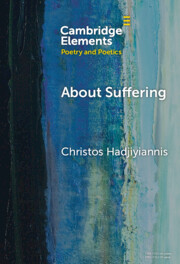Refine search
Actions for selected content:
159 results
14 - Atonement
- from Part II - Theological Themes
-
-
- Book:
- The Origins of Scholasticism
- Published online:
- 18 November 2025
- Print publication:
- 08 January 2026, pp 388-412
-
- Chapter
- Export citation
Retrieving Teresa of Avila’s Resiliency in the Interior Castle
-
- Journal:
- Horizons , First View
- Published online by Cambridge University Press:
- 01 December 2025, pp. 1-25
-
- Article
- Export citation
“They had to watch”: How parents perceive the suffering of siblings of children with cancer
-
- Journal:
- Palliative & Supportive Care / Volume 23 / 2025
- Published online by Cambridge University Press:
- 10 October 2025, e184
-
- Article
-
- You have access
- Open access
- HTML
- Export citation
The problem of misfortunes
-
- Journal:
- Religious Studies , First View
- Published online by Cambridge University Press:
- 06 October 2025, pp. 1-12
-
- Article
-
- You have access
- Open access
- HTML
- Export citation
Chapter 4 - Compassion
- from Part II - Virtues of Direct Caring
-
- Book:
- Attention to Virtues
- Published online:
- 25 July 2025
- Print publication:
- 14 August 2025, pp 65-84
-
- Chapter
- Export citation
Panpsychism’s problem of evil?
-
- Journal:
- Religious Studies , First View
- Published online by Cambridge University Press:
- 01 August 2025, pp. 1-13
-
- Article
-
- You have access
- Open access
- HTML
- Export citation
Epilogue
-
- Book:
- Law and Inhumanity
- Published online:
- 20 June 2025
- Print publication:
- 17 July 2025, pp 121-125
-
- Chapter
- Export citation
6 - Silent Claims and the Limits of International Criminal Law
-
- Book:
- Law and Inhumanity
- Published online:
- 20 June 2025
- Print publication:
- 17 July 2025, pp 103-120
-
- Chapter
- Export citation
9 - Sermons on Feasts of the Martyrs
- from Part II - Augustine’s Sermons on the Scriptures and Liturgical Feasts
-
-
- Book:
- The Cambridge Companion to Augustine's Sermons
- Published online:
- 26 May 2025
- Print publication:
- 12 June 2025, pp 169-190
-
- Chapter
- Export citation
Chapter 20 - Suffering as God’s Will
- from Part V - The Unspeakable/Unassailable
-
-
- Book:
- Complex Ethics Consultations
- Published online:
- 17 May 2025
- Print publication:
- 05 June 2025, pp 156-161
-
- Chapter
- Export citation
Chapter 11 - Misjudging Needs
- from Part III - Diversity of Desires and Limits of Liberty
-
-
- Book:
- Complex Ethics Consultations
- Published online:
- 17 May 2025
- Print publication:
- 05 June 2025, pp 90-95
-
- Chapter
- Export citation
Buddhism and Disasters: From World War II to Fukushima
-
- Journal:
- Asia-Pacific Journal / Volume 10 / Issue 11 / March 2012
- Published online by Cambridge University Press:
- 07 May 2025, e8
-
- Article
-
- You have access
- Open access
- Export citation
2 - The Definition of Other Ill-Treatment under International Law
-
- Book:
- The Prohibition of Torture and Ill-Treatment under International Law
- Published online:
- 17 April 2025
- Print publication:
- 24 April 2025, pp 46-74
-
- Chapter
- Export citation
La place du genre et des rôles dans la souffrance des hommes âgés atteints d’un cancer incurable
-
- Journal:
- Canadian Journal on Aging / La Revue canadienne du vieillissement / Volume 44 / Issue 2 / June 2025
- Published online by Cambridge University Press:
- 02 April 2025, pp. 243-253
-
- Article
-
- You have access
- Open access
- HTML
- Export citation
Biological research on mental pain, social pain and other pains not primarily felt in the body: methodological systematic review
-
- Journal:
- The British Journal of Psychiatry / Volume 227 / Issue 4 / October 2025
- Published online by Cambridge University Press:
- 21 March 2025, pp. 707-717
- Print publication:
- October 2025
-
- Article
-
- You have access
- Open access
- HTML
- Export citation
Suffering at the Margins: Non-Experiential Suffering and Disorders of Consciousness
-
- Journal:
- Cambridge Quarterly of Healthcare Ethics , First View
- Published online by Cambridge University Press:
- 18 March 2025, pp. 1-9
-
- Article
-
- You have access
- Open access
- HTML
- Export citation
Suffering and Intellectual (Dis)Ability
-
- Journal:
- Cambridge Quarterly of Healthcare Ethics , First View
- Published online by Cambridge University Press:
- 10 March 2025, pp. 1-8
-
- Article
-
- You have access
- Open access
- HTML
- Export citation
19 - Chapter
-
- Book:
- Dark Justice
- Published online:
- 07 March 2025
- Print publication:
- 06 March 2025, pp 145-151
-
- Chapter
- Export citation
How do Persons With Dementia Suffer?
-
- Journal:
- Cambridge Quarterly of Healthcare Ethics , First View
- Published online by Cambridge University Press:
- 20 February 2025, pp. 1-8
-
- Article
-
- You have access
- Open access
- HTML
- Export citation

About Suffering
- On Louise Glück
-
- Published online:
- 17 February 2025
- Print publication:
- 13 March 2025
-
- Element
- Export citation
